Course: Human Computer Interaction Studio
Time: Fall 2012
Members: Irina Dubinskaya, Susie Forbath
Role: User Research, Wireframing, Usability Testing
Skills/Tools: Photo Study, Directed Storytelling, Picture Cards, Affinity Diagram, Paper Prototypes, Medium-fidelity Prototypes
StuffSwap: A mobile application that nudges people to live sustainably without lifestyle changes
StuffSwap is a platform that connects outgoing tenants and incoming tenants in Collegetown to share and reuse items within the apartment. Outgoing tenants can use the StuffSwap to upload items that he or she would like to leave behind. Incoming tenants can use StuffSwap to reject or accept the items that are offered by the outgoing tenants.
Before StuffSwap, students threw out things when moving out of the apartment at the end of school year. These things are often in good conditions but hard to be taken home, and new tenants buy the exact same things when they move in. With StuffSwap, outgoing tenants can save the efforts of throwing items that they don't want to carry with while moving out; incoming tenants would know exactly what items are available to them when they move into the apartment.
User Research: Photo Study & Directed Storytelling
We asked participants to take pictures of when they were doing something sustainable over a 24 hour period and to email those pictures to us. We then used these photos to trigger our participants to provide the story and specific details behind their images.
The results showed that "convenience" and "benefit to me" are major barriers for students when they are making choices related to sustainability. Our design should help people overcome these barriers to motivate them to make sustainable choices.
Brainstorming
During the brainstorming session we came up with around one hundred ideas, then reviewed those ideas to find common themes among them.
Storyboarding the Promising Idea
To depict the scenario and persona of the promising idea, we sketched out the idea into the storyboard and presented it to the class so that our classmates and instructor could give us quick comments about the idea.
Testing the Idea
After receiving initial feedback from our instructor and classmates, we conducted several tests with our target users to validate if our idea is receptive.
We asked participants to use sticky notes to label what types of items they want to leave behind when they move out of their apartments. Then we conducted a card sorting task to ask users about what types of items they're willing to accept from former tenants of their apartment. In addition, the users were asked to list what types of items do they wish were waiting for them when they move into their apartments.
We also interviewed a landlord to understand her thoughts and concerns about StuffSwap.
Analysis of User Data
The Venn diagram below shows a synthesis of our tests results. The left section contains
items that current tenants want to leave, but future tenants would not accept. The right section
contains items that current tenants would like to have waiting for them in the apartment that have
not been offered by any outgoing tenants. The middle section represents the types of items that our users would swap, which is the niche for StuffSwap.
The landlord told us that StuffSwap made sense to her because she saw "a lot of things were being thrown out." and "I'd rather see all that used again than thrown out". The postitive feedback from the landlord indicated that StuffSwap could be a promising solution to reduce waste and reuse items.

Paper Prototypes: Web-based Version of StuffSwap
At this low-fidelity prototype step, StuffSwap was originally designed as a Web application. However, we got feedback that it would be easier and faster for users to take photos of the items that they want to leave with their smartphones and directly upload the photos from their smartphones to StuffSwap.
Based on this feedback, we decided to redesign the user interface for tenants as a mobile application in our next design iteration. The user interface for landlords will still be a Web based version since it’s easier for landlords to enter emails of tenants and lease information these kinds of written details with a full size screen.

Medium-Fidelity Prototype: Web-based and Mobile App versions of StuffSwap
In the medium-fidelity prototype step, we implemented the mobile version of UI for tenants and the web version of UI for landlords.
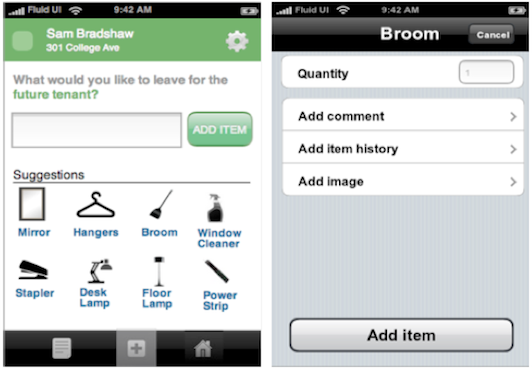
User Interface for Outgoing Tenants
The mobile application is useful for outgoing tenants as it allows one to take pictures and upload them easily as they are moving around the house.

User interface for Landlords
A full size screen is easier for landlords to enter emails of tenants and lease information these kinds of written details.
FInal Version of StuffSwap
To keep consistency between the various screens, we used a pre-made grid designed for the iPhone and edited it to suit our content. By overlaying this grid on top of each of our screens, we could ensure that our application was visually pleasing, as can be discerned from the screens below.

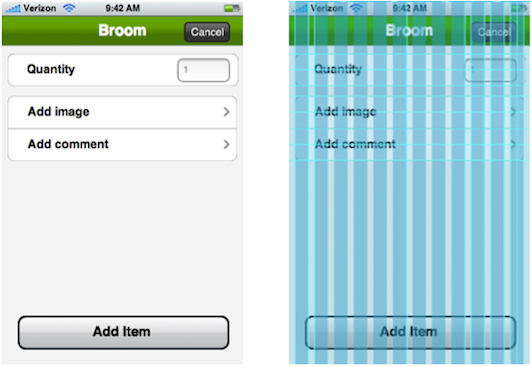
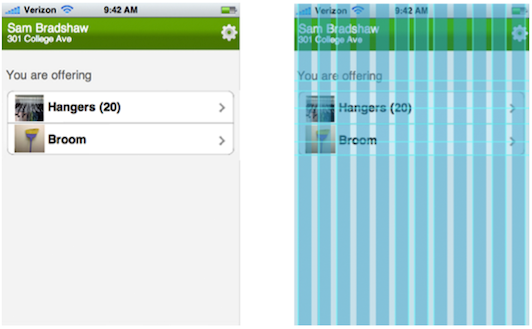
User Interface for Outgoing Tenants
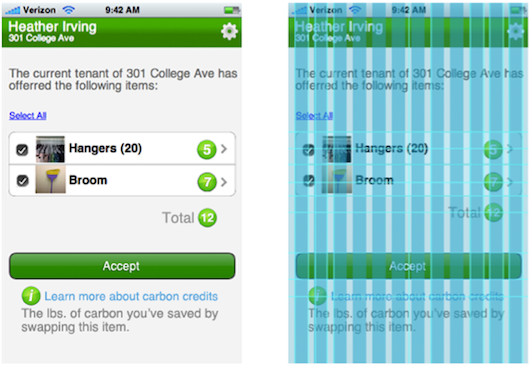
User Interface for Incoming Tenants
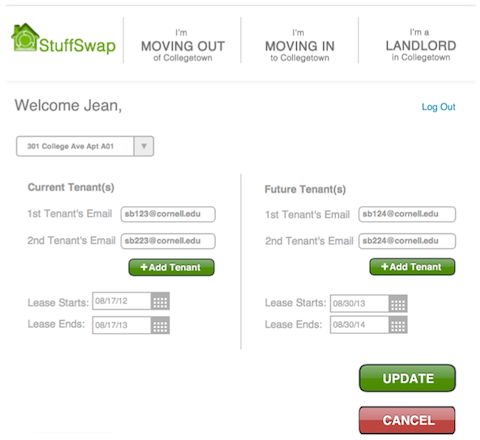
User Interface for Landlords
Since the landlord interface is a webpage rather than a mobile App page, we used the same header as StuffSwap website has to keep the consistency. The design of StuffSwap website will be shown in the next section.
The Website of StuffSwap
Our website includes a top navigation comprised of three major buttons -- one for each of the three use cases of our application -- as well as our logo which serves as a link back to the homepage. By having a separate page for each of these use cases, the visitor can discover how their specific needs can be catered by the StuffSwap system.
The website of StuffSwap were inspired by the Square (http://squareup.com) and WhatsApp (http://whatsapp.com).
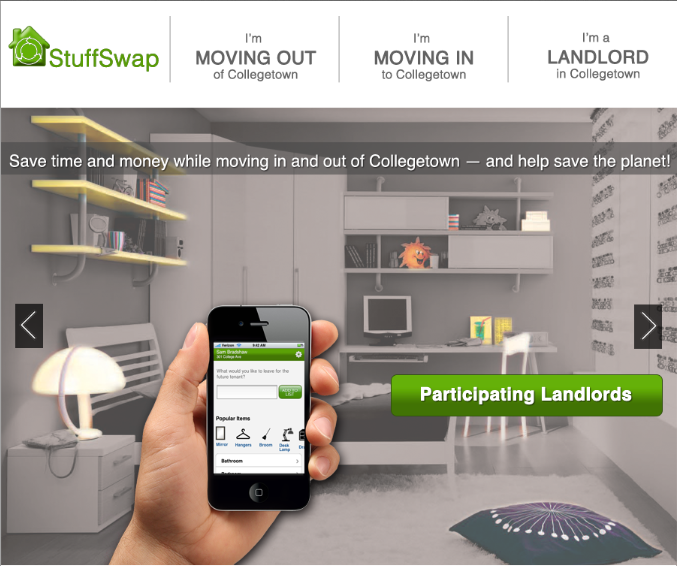
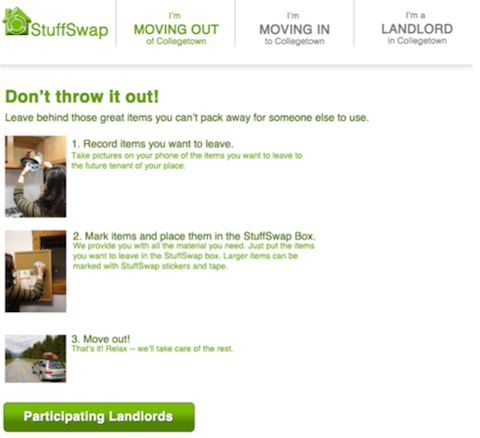
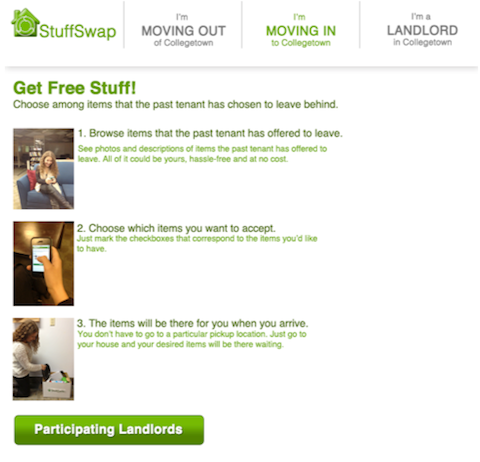
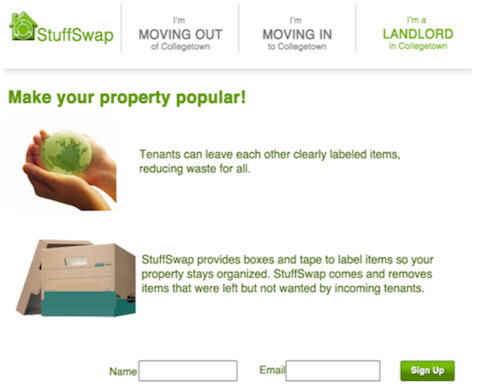
Future Step: Make StuffSwap a Self-sustainable Business
StuffSwap is an exploratory project in sustainable HCI field. The positive feedback from tenants and landlords shows that this exploration is promising and exciting. The future step would be how to launch StuffSwap and make it as a sustainable business. To actually implement the idea of StuffSwap, we not only have to take user interface design into consideration, but also need to propose business models to provide StuffSwap with financial suppot.
We brainstormed several means of financing the operation that could help StuffSwap break even. We attempted to calculate the specific amount of tons of carbon dioxide that would be saved per item by reusing it rather than recycling it or throwing it away and sell these credits to carbon trading company to make profits.
Another idea was to register StuffSwap as a non-profit organization and solicit donations. We believe that we would appeal to the same segment of the population that is interested in purchasing carbon credit through websites like TerraPass.


